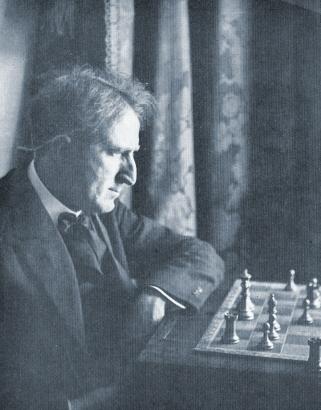
Edward Winter

Frank James Marshall
We offer some historical notes on the Marshall Gambit in the Ruy López (1 e4 e5 2 Nf3 Nc6 3 Bb5 a6 4 Ba4 Nf6 5 O-O Be7 6 Re1 b5 7 Bb3 O-O 8 c3 d5).
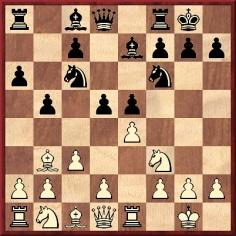
The then US champion, Frank James Marshall, played 8...d5 against Capablanca in the first round of the New York, 1918 tournament, and some writers still perpetuate the myth that Marshall held the gambit in reserve for many years to spring it on the Cuban. For example, C.N. 3097 quoted from page 20 of Every Move Must Have a Purpose by Bruce Pandolfini (New York, 2003):
‘Humiliated by the loss [his match defeat by Capablanca in 1909], Marshall diligently trained for some future encounter with the Cuban. He developed a curious gambit that seemed to afford him splendid chances regardless of how Capablanca replied, and he practiced in private to keep his plan a secret.
Seven years went by before Marshall’s opportunity came knocking. He unveiled his new setup at the Manhattan Chess Club Masters Tournament in New York [in 1918] …’
We commented in C.N. 3097:
‘Marshall did not have to wait “seven years”. Page 93 of our book on Capablanca pointed out that between 1910 and 1918 the Cuban played 1 e4 against Marshall on six occasions. Five times the American responded with the Petroff Defence and once with the French Defence. As little as three years before Marshall played his 8…d5 gambit he was still unwilling to face 1 e4 e5 2 Nf3 Nc6 3 Bb5 from Capablanca.’
Whether Marshall played the 8…d5 line before his meeting with Capablanca is a question raised in C.N. 1798. An oft-published game is Walter Frere v Marshall, ‘New York, 1917’ (see, for instance, pages 238-239 of 1000 Best Short Games of Chess by Irving Chernev), but we have yet to find it in a magazine or column of the time. As mentioned in C.N. 2332, Marshall published the Frere game on pages 110-111 of his rarely-seen book Comparative Chess (Philadelphia, 1932):
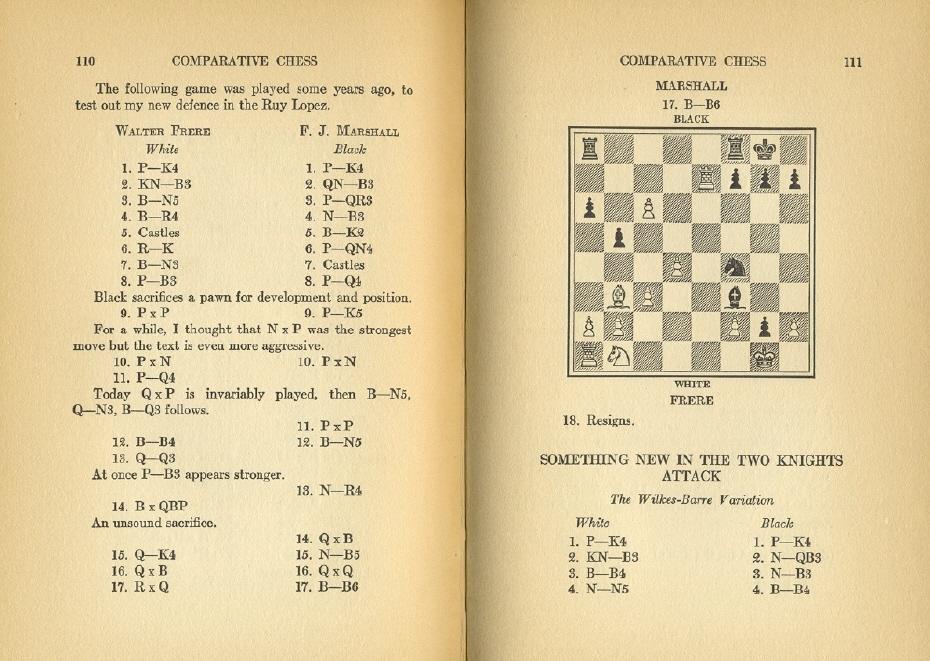
It will be noted that Marshall offered no date or venue, merely announcing, ‘The following game was played some years ago, to test out my new defence in the Ruy Lopez.’
A further curiosity in Comparative Chess, also pointed out in C.N. 2332, is that on page 104 it was 7…O-O, rather than 8…d5, that Marshall emphasized. Of 7…O-O he wrote (incorrectly), ‘This move of mine, I claim to be original’.
From page 135 of The Greatest Ever chess opening ideas by Christoph Scheerer (London, 2008):
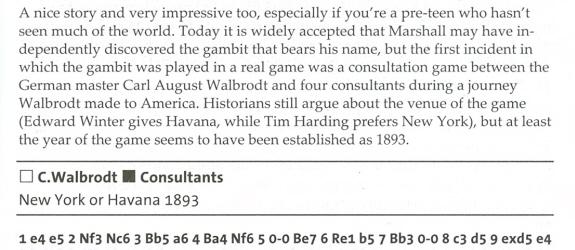
We are aware of no ‘argument’ about the venue of the Walbrodt game, which was given in C.N. 1996 (see page 151 of Kings, Commoners and Knaves). He played the game in Havana on 18 or 19 February 1893 against four Cuban amateurs: Enrique Conill, Enrique Ostolaza, López and Herrera. In another encounter involving the same players Walbrodt was Black.
As shown below, the ‘Marshall Gambit’ game was published on pages 22-23 of the February 1893 issue of The Chess World (a magazine based in Washington, DC) and on pages 120-121 of Deutsches Wochenschach, 2 April 1893:
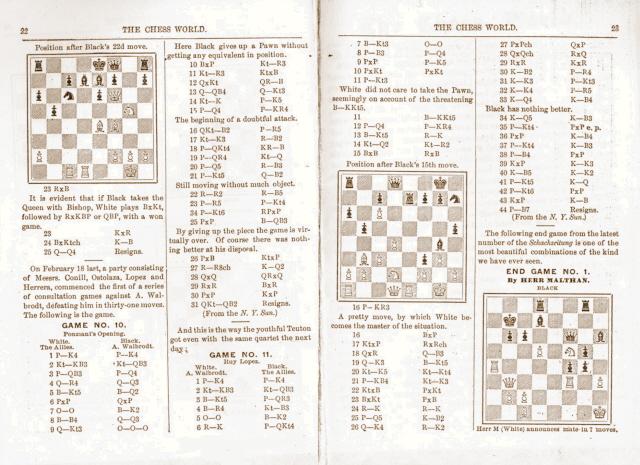
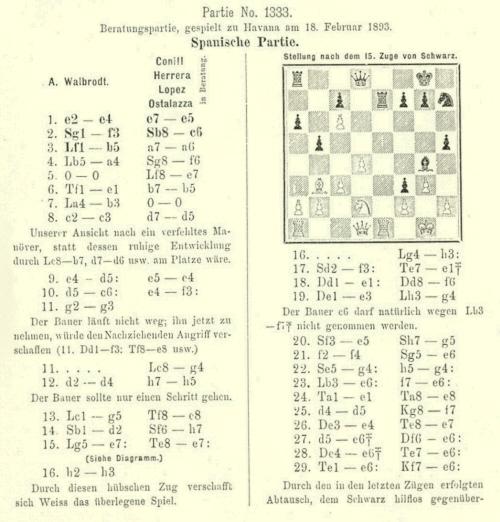
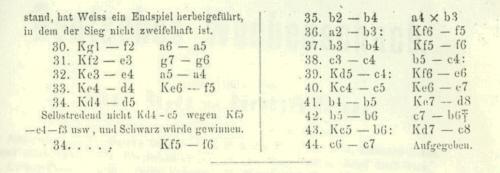
The Deutsche Schachzeitung (pages 110-111 of the April 1893 issue) gave only the game in which the Allies had the white pieces:
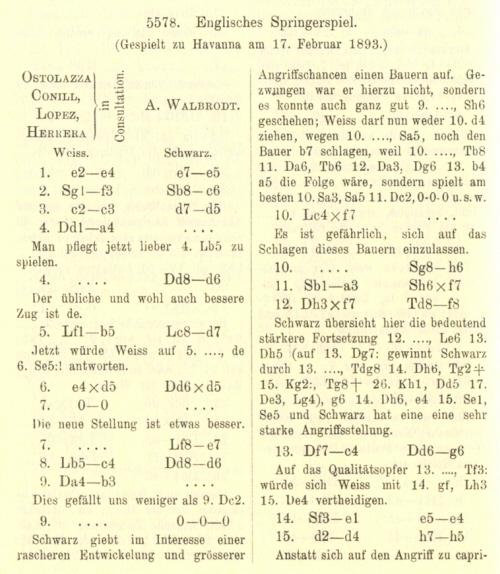
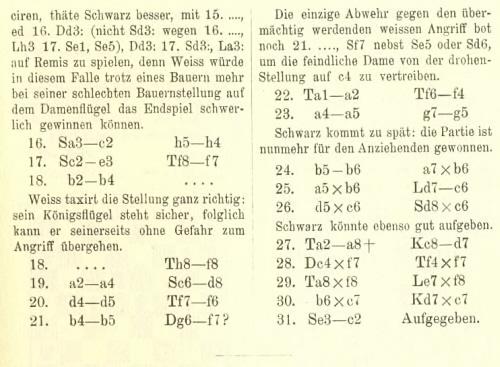
We believe that the German magazines’ spellings of the name Ostolaza were incorrect. See page 23 of Ajedrez en Cuba by Carlos A. Palacio (Havana, 1960).
(5664)
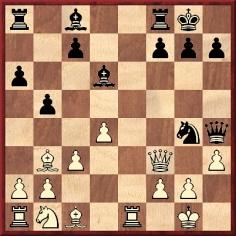
Regarding Capablanca v Marshall, New York, 1918, page 259 of part one of Garry Kasparov on My Great Predecessors (London, 2003) quotes Capablanca’s note in My Chess Career on 15...Nxf2: ‘The trapper trapped. Black, however, had nothing better, and had to go on with the attack to do or die’. Kasparov’s book then comments:
‘Not reckoning on Shamkovich’s idea 15...h5!? 16 Be3 (16 Nd2 Bh2+ 17 Kf1 Bd6! is equal) 16...Nxe3 17 Rxe3 Qf4 18 Qxf4 Bxf4 19 Re1 Bf5, when Black’s two powerful bishops prevent White from converting his extra pawn.’
In fact, Capablanca’s earlier set of notes (on page 12 of the New York, 1918 tournament book) did ‘reckon on’ the move 15...h5, and he even suggested that it may have been the best move. He wrote of 15...Nxf2:
‘Very likely a mistake and overlooking the reply. 15...h5 was perhaps the best way to keep up the pressure.’
In My Chess Career, however, the Cuban made no mention of 15...h5.
Below, for the record, we give in full his brief notes to the game in the tournament book:
7...O-O: ‘Castling has been supposed to be undesirable at this point, on account of 8 Bd5.
8...d5: ‘The sacrifice, if accepted, yields Black a powerful attack, although of a doubtful nature, and I am inclined to think that White should come out with advantage.’
12 Re1: ‘12 d4 looks like the natural move, but leads to the same thing.’
13 h3: ‘If 13 d4, then will follow 13...Ng4.’
15 d4: ‘The tempting move of 15 Re8 is met by 15...Bb7 16 Rxf8+ Rxf8 17 Qxg4 Re8 18 Kf1 Qe7 19 Be6 Bd5, and Black has the best of it.’
15...Nxf2: ‘Very likely a mistake and overlooking the reply. 15...h5 was perhaps the best way to keep up the pressure.’
18...Bg3: ‘The alternative was 18...Nh1, leading to a complicated game, but always White is apparently able to find a valid defense.’
19 Rxf2: ‘19 Ke1 was also feasible, as it is not possible for Black to play 19...Rae8 on account of 20 Qxf7+.’
22...Rae8+: ‘As it is important for Black to avoid exchanging queens he is now compelled to drive the king to c2 and presently also his rooks are on the wrong side of the board.’
28...Bd6: ‘If, instead, 28...Be3 29 Bxe3 Rxe3 30 Nd2!’
36 Bxf7+: ‘White forces checkmate in six moves.’
Below is the only photograph we recall from the New York, 1918 tournament, which was held at the Manhattan Chess Club. It appeared at the front of the tournament book and on page 252 of the December 1918 American Chess Bulletin. The caption quoted was in both sources.
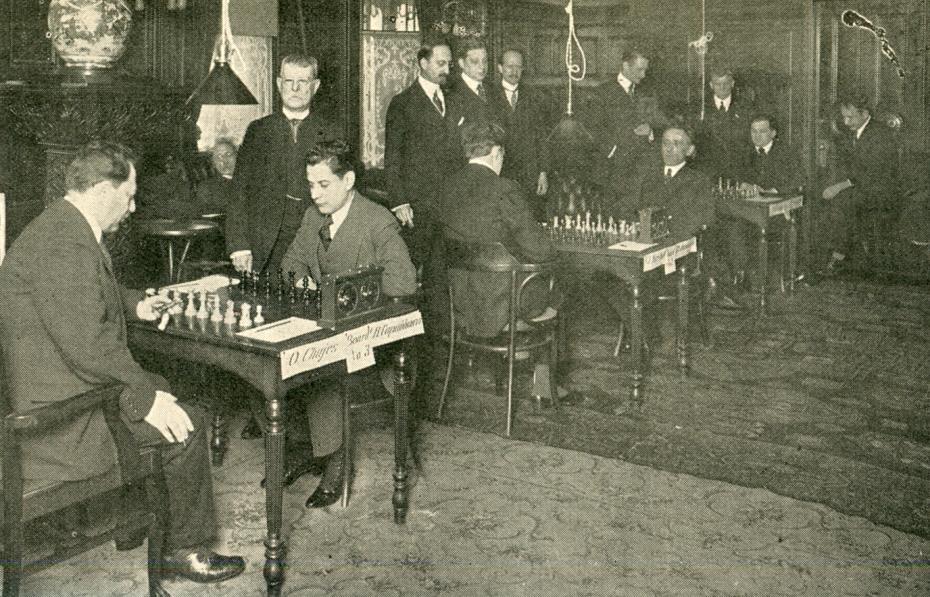
‘Seated, from left to right: O.
Chajes, A. Ettlinger (by window), J.R. Capablanca, F.J.
Marshall, D. Janowsky, J.S. Morrison (obscured), B. Kostić, E.B.
[or B.B.] Edwards
Standing, from left to right: A. Martinez (President), H.R.
Limburg (Vice-President), R. Raubitschek (Treasurer), H. Helms
(Umpire), W. Malowan (Secretary), J. Kraus (Serjeant-at-Arms)’
(3980)
How exactly did the famous 1918 encounter between Capablanca and Marshall end? On page 90 of The Immortal Games of Capablanca (New York, 1942) Fred Reinfeld stated that after 35...Re3 ‘Capablanca announced mate in five [sic]’, beginning with 36 Bxf7+.
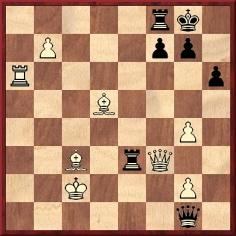
On page 187 of My Chess Career (London, 1920) Capablanca wrote after 35...Re3, ‘BxPch and mate in five moves’. The Cuban also annotated the game on page 12 of the New York, 1918 tournament book. As mentioned in our feature article on the game, the note appended to 36 Bxf7+ read, ‘White forces checkmate in six moves’. No mate announcement was suggested.
From the report on page 14 of the New York Times, 24 October 1918:
‘At the time of the evening adjournment Capablanca had begun to get a real hold on the position. After resumption of play in the evening session, Marshall did not last much longer and was finally pushed to the wall with a forced checkmate in five moves.’
At which move was the game adjourned? As regards the playing arrangements, page 7 of the tournament book stated:
‘There were two sessions daily, from 2.30 p.m. to 6.30 p.m. and from 8.00 p.m. to 11 p.m. The time-limit was 30 moves in the first two hours and 15 moves an hour thereafter.’
(6023)
Regarding the involvement of Vassily/Basil Soldatenkov in the Marshall Gambit, see C.N. 6138.
We are still trying to determine when the Frere v Marshall game first appeared with the date 1917, i.e. the year before the Marshall Gambit was played by the US champion against Capablanca. The earliest instance found so far remains pages 238-239 of 1000 Best Short Games of Chess by Irving Chernev (New York, 1955):
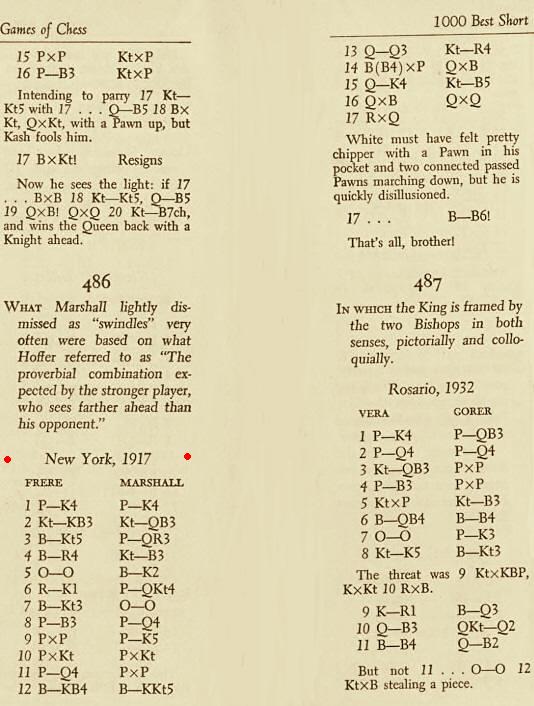
On page 11 of the January 1983 Chess Life A. Soltis wrote regarding the opening of Capablanca v Marshall, New York, 1918:
‘But how much of a surprise was it really? A year before his attempt at revenge against Capablanca, Marshall saw this game published ...’
There followed Frere v Marshall, ‘New York, 1917’. Mr Soltis’ account being devoid of any sources, it can only be wondered on what specific grounds he stated that Marshall saw the Frere-Marshall game published in 1917. We have found the game nowhere prior to Marshall’s Comparative Chess (Philadelphia, 1932), a book which, moreover, gave the game datelessly.
(6777)
Sinischa – Poliaxoff (Poljakhov?)
Belgrade, 1924
Ruy López
1 e4 e5 2 Nf3 Nc6 3 Bb5 a6 4 Ba4 Nf6 5 O-O Be7 6 Re1 b5 7 Bb3 O-O 8 c3 d5 9 exd5 Nxd5 10 d3 Bg4 11 Nbd2 Nf4 12 Bc2 Nxd3 13 Bxd3 Qxd3 14 h3 Bh5 15 g4 Bg6 16 Nxe5 Nxe5 17 Rxe5 Qd7 18 Qe2 Bd6 19 Re3 Bc5 20 Rg3 Rfe8 21 Qf3 Re1+ 22 Kg2 Rae8 23 b4
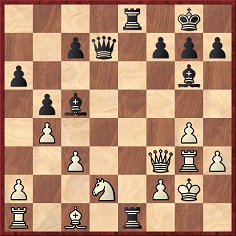
23…Bxf2 24 Kxf2 Qe6 25 Kg2 Qb6 26 Kh2 R8e2+ 27 Rg2 Qg1+ 28 Kg3 Rxg2+ 29 Qxg2 Re3+ 30 Nf3 Rxf3+ 31 Kxf3 Be4+ 32 Resigns.
Our source is the two-volume Schachjahrbuch 1924 by Ludwig Bachmann (see Chess in 1924).
Charles Jaffe and H.E. Cleland – Frank James Marshall and
Edward M. Padelford
New York, circa 15 February 1918
Ruy López
1 e4 e5 2 Nf3 Nc6 3 Bb5 a6 4 Ba4 Nf6 5 O-O Be7 6 Re1 b5 7 Bb3 O-O 8 a4 b4 9 c3
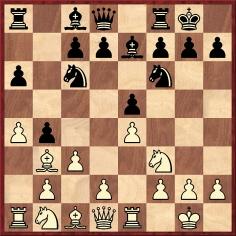
9...d5 10 exd5 Nxd5 11 Nxe5 Nxe5 12 Rxe5 Nf6 13 h3 Bd6 14 Re1 Ng4 15 Qf3 Qh4 16 d4
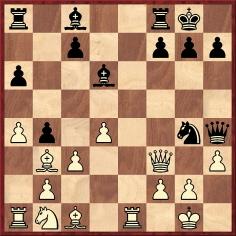
16...h5 17 Bd5 Rb8 18 Nd2 bxc3 19 bxc3 Be6 20 Bc6 Rb6 21 Ne4 Bh2+ 22 Kh1 f6 23 Ba3 Rxc6 24 Bxf8 Bd5 25 Qf5
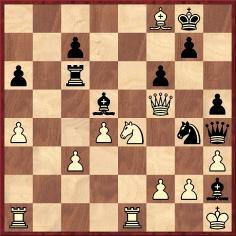
25...Be5 26 dxe5 Bxe4 27 Rxe4 Nxf2+ 28 Kg1 Qxe4 29 Qxf2 Kxf8 30 exf6 Rxf6 31 Qc5+ Kg8 32 Rd1 Qe2 33 Rd8+ Kh7 34 Qxc7 Rf1+ 35 Kh2 Qe1 36 White resigns.
Source: Brooklyn Daily Eagle, 7 March 1918, page 6:
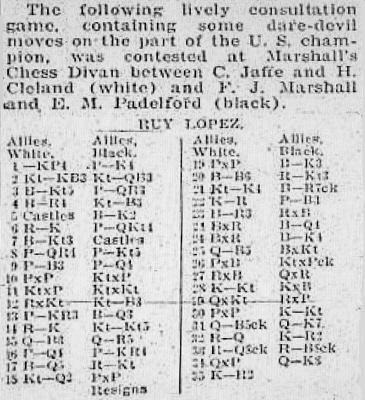
The game-score has been contributed by Eduardo Bauzá Mercére (New York, NY, USA), who writes:
‘With the moves 8 a4 b4 added, here is Marshall playing his Gambit many months before his encounter with Capablanca (which was played on 23 October 1918). The consultation game probably took place on 15 February 1918 at Marshall’s Chess Divan. That was the day of the third annual dinner, presided over by H.E. Cleland. A rapid transit tournament was also played that day (New York Post, 16 February 1918, page 12; see too the American Chess Bulletin, March 1918, page 53).
It will be noted that Marshall even played 16 (15)...h5, a move discussed in your feature article on the Marshall Gambit.’
(6980)
Three games in which Black deviated from the Capablanca v Marshall game by playing 20...Qxc1 rather than 20...Bxf2:
Page 21 of Modern Chess Preparation by V. Tukmakov (Alkmaar, 2012) follows Kasparov in erroneously ascribing the idea of 15... h5 to Shamkovich, whereas Capablanca himself had pointed it out.
On page 127 of World Chess Championship Kramnik vs. Leko (Aylesbeare, 2004) Raymond Keene wrote:
‘... when faced with Marshall’s gambit in the first game of their 1918 match, Capablanca rose to the occasion.’
C.N. 10788 noted the reference to Marshall as the ‘Dean of American Chess’ on page 67 of the March 1943 Chess Review. That was in the introduction to a feature about the Marshall Gambit on pages 67-70:
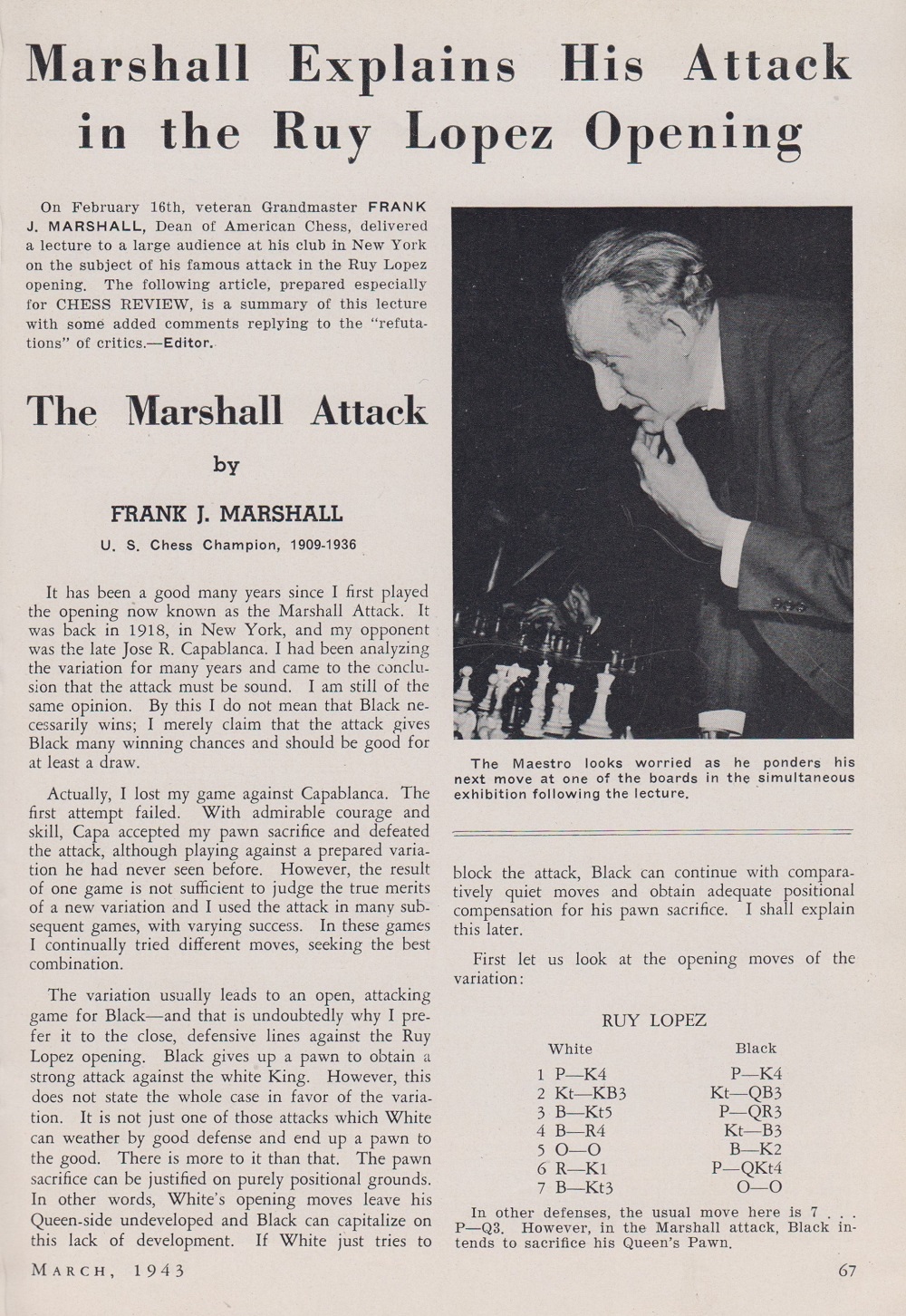
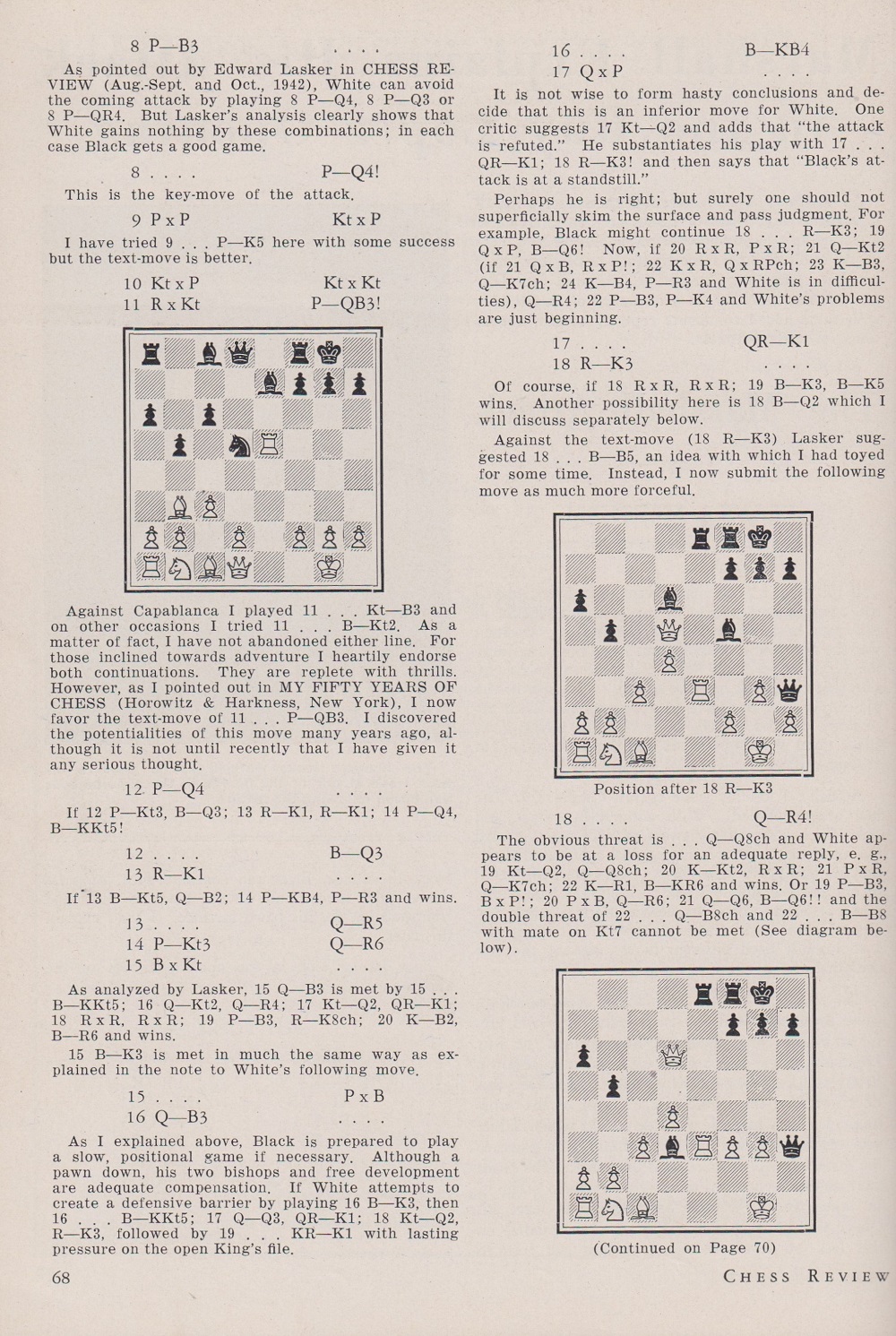
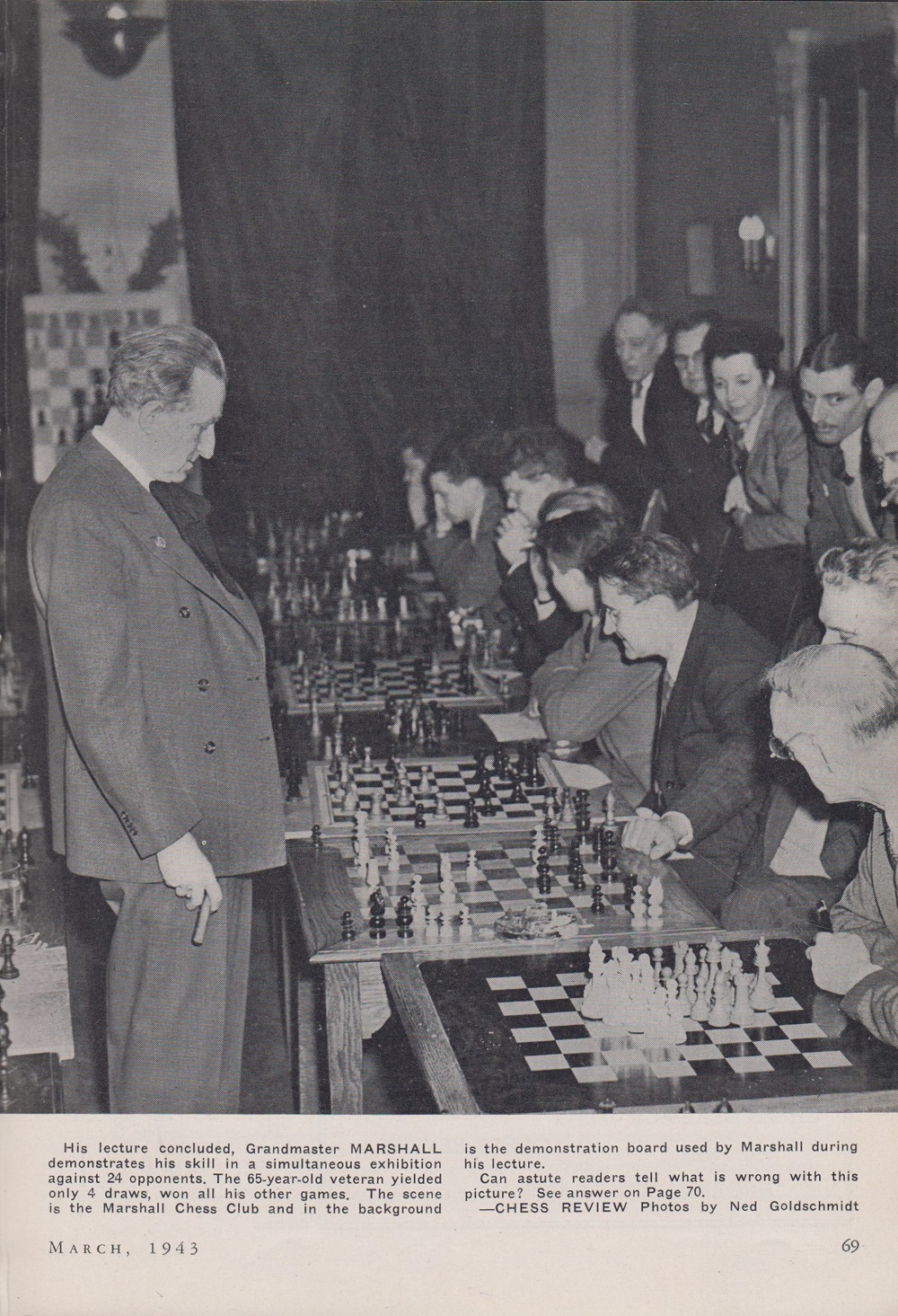
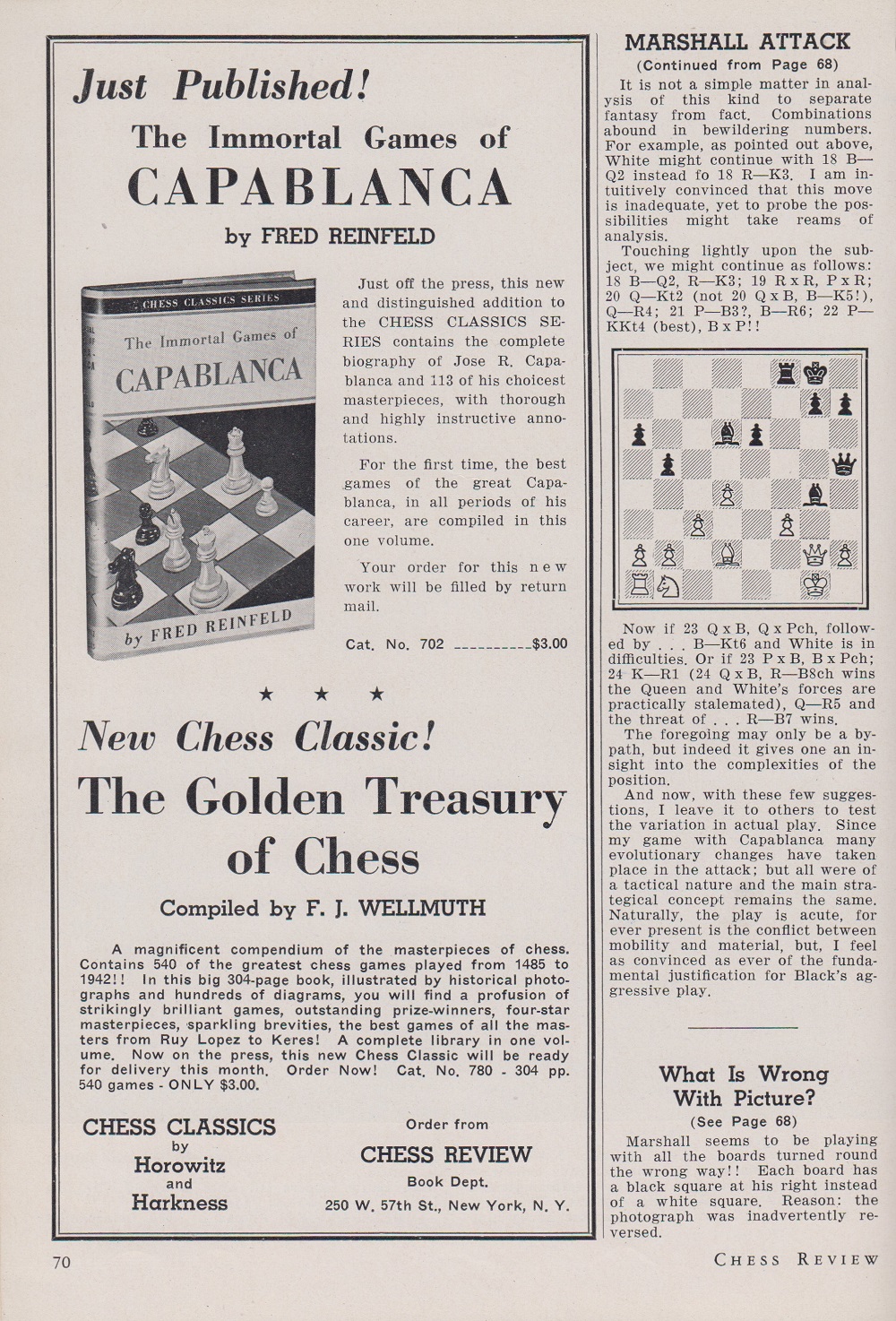
The present item discusses two analytical points in Capablanca v Marshall, New York, 1918 (which began 1 e4 e5 2 Nf3 Nc6 3 Bb5 a6 4 Ba4 Nf6 5 O-O Be7 6 Re1 b5 7 Bb3 O-O 8 c3 d5 9 exd5 Nxd5 10 Nxe5 Nxe5 11 Rxe5 Nf6 12 Re1 Bd6 13 h3 Ng4 14 Qf3 Qh4 15 d4 Nxf2 16 Re2 Bg4 17 hxg4 Bh2+ 18 Kf1 Bg3 19 Rxf2 Qh1+ 20 Ke2 Bxf2).
Firstly, an analytical oversight by Capablanca:
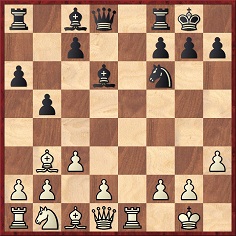
Position after 13 h3
Marshall now played 13...Ng4, and the Cuban wrote in My Chess Career:

Page 157 of the 1994 algebraic edition of My Chess Career changed Capablanca’s words and added an editorial note in italics:

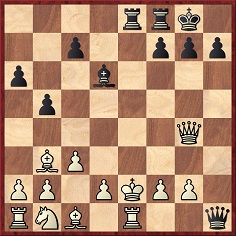
Position in Capablanca’s analysis after 18...Rae8+
Lest it be assumed that 19 Be6 was a suggestion original to that 1994 book, we show, firstly, what had appeared on pages 104-105 of Kapablanka by V. Panov (Moscow, 1959):
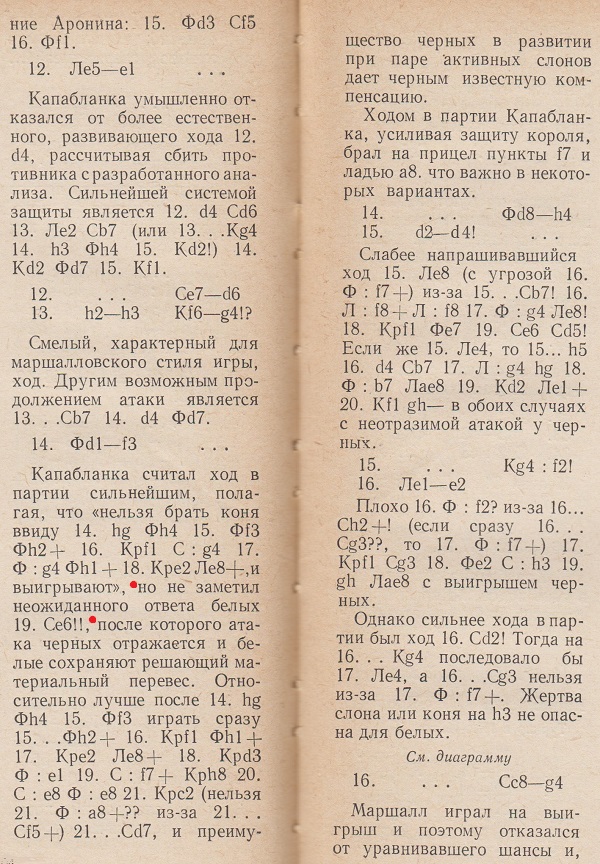
On page 141 of a subsequent (1970) monograph on the Cuban, Panov ascribed the discovery of 19 Be6 to E. Palkin of Leningrad, 36 years after the game was played:
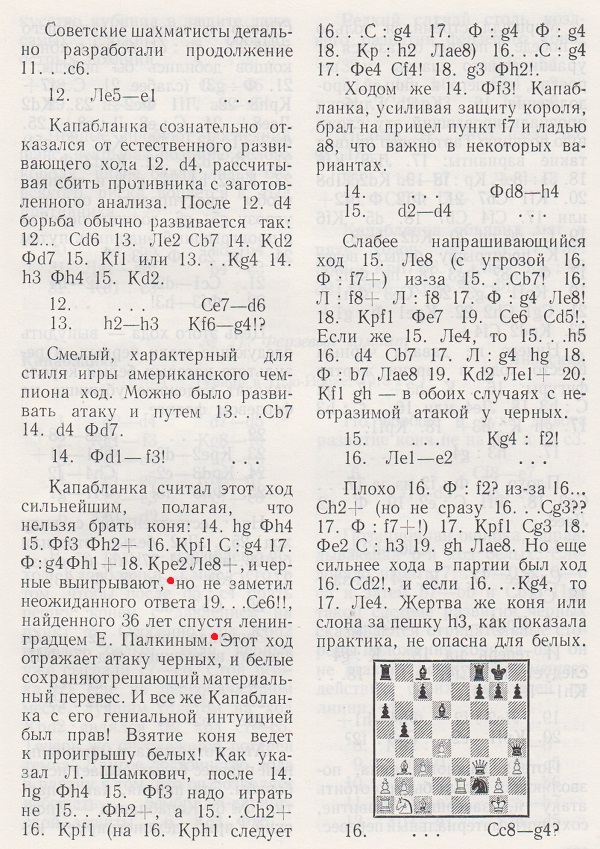
Palkin was also mentioned by Leonid Shamkovich in an article about the game on pages 28-30 of the September 1985 Chess Life:
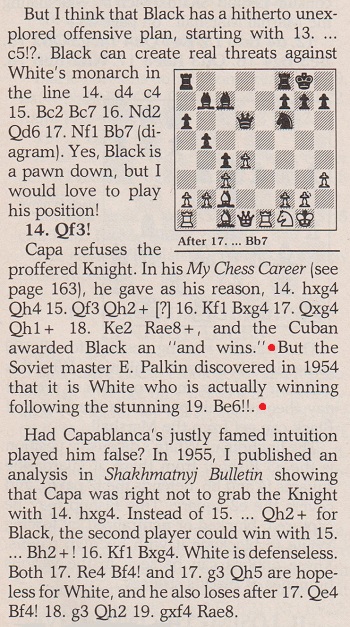
Wanted: more information about the discovery of 19 Be6 by E. Palkin in the mid-1950s and, more generally, about Palkin himself.
The second, less intricate, analytical point concerns the board position after Marshall’s move 15...Nxf2:
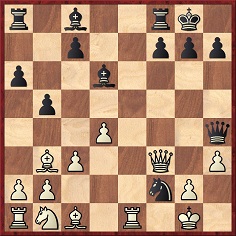
From page 164 of the March 1919 Chess Amateur:
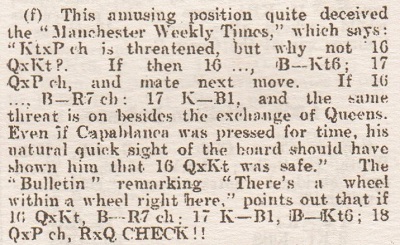
Does a reader have access to the Manchester Weekly Times (chess columnist: V.L. Wahltuch)?
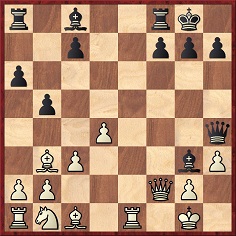
White plays 17 Qxf7+
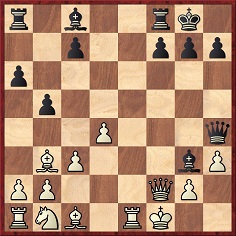
White does not play 18 Qxf7+.
(10909)
Olimpiu G. Urcan (Singapore) has found this picture in the photogravure section (pages unnumbered) of the Baltimore Sun, 1 December 1918:
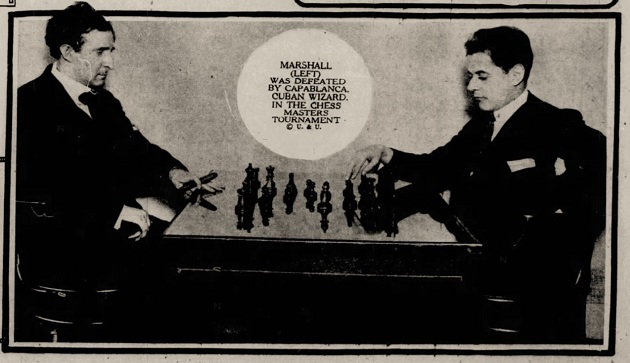
(10910)

White can play 19 Be6
The request in C.N. 10909 for information about the publication in which E. Palkin reported that analysis by Capablanca in My Chess Career missed 19 Be6 has been answered by Andrey Terekhov (Singapore) and Vitaliy Yurchenko (Uhta, Komi, Russian Federation), both of whom have provided page 50 (‘Readers’ letters’) of the 2/1954 issue of Shakhmaty v SSSR:
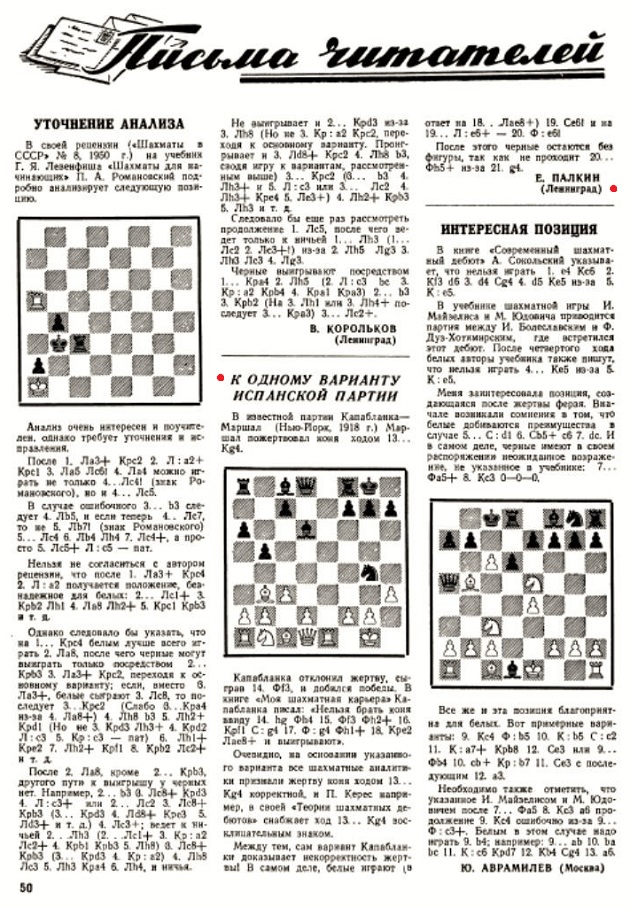
(10914)
For further information about E. Palkin, see C.N. 10924.
From Dan Scoones (Port Coquitlam, BC, Canada) comes a Marshall Gambit game published on pages 2-3 of the 4/1976 issue of Shakhmaty Riga, in an article by Grigory Abramovich Goldberg:
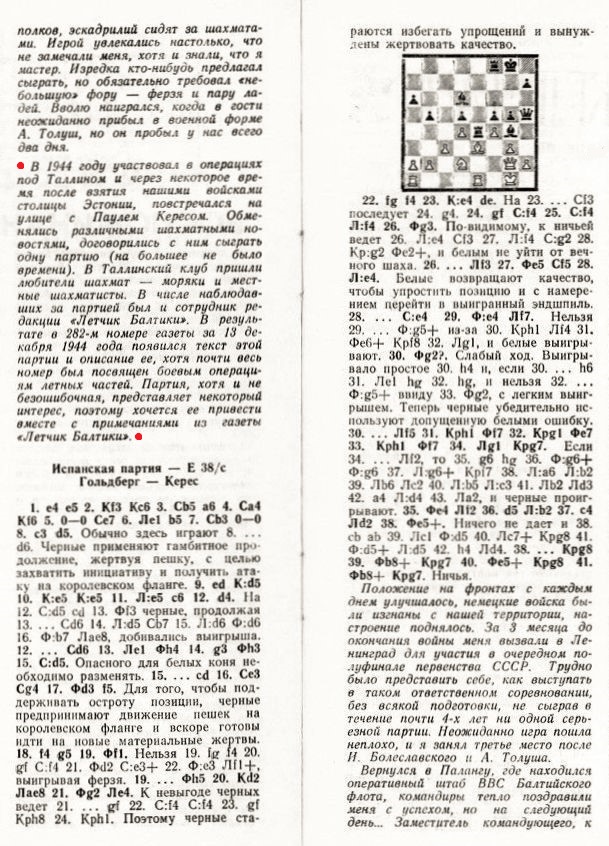
Our correspondent’s translation of the marked passage:
‘In 1944 I was taking part in military operations near Tallinn. A short time after our forces recaptured the city, I ran into Paul Keres in the street. We exchanged various pieces of news from the chess world and agreed to play a game (there was not time for more than one). This drew some chess aficionados to the Tallinn club, including sailors and local chessplayers. Among the spectators at this game was an editorial assistant of the newspaper Baltic Aviator. As a result, issue #282 for 13 December 1944 carried the text of the game and a short account of it, but of course most of the issue was concerned with military operations by our air forces. The game is not free of errors, but is still of some interest; I should therefore like to present it here, along with the comments from Baltic Aviator.’
1 e4 e5 2 Nf3 Nc6 3 Bb5 a6 4 Ba4 Nf6 5 O-O Be7 6 Re1 b5 7 Bb3 O-O 8 c3 d5 9 exd5 Nxd5 10 Nxe5 Nxe5 11 Rxe5 c6 12 d4 Bd6 13 Re1 Qh4 14 g3 Qh3 15 Bxd5 cxd5 16 Be3 Bg4 17 Qd3 f5 18 f4 g5 19 Qf1 Qh5 20 Nd2 Rae8 21 Qg2
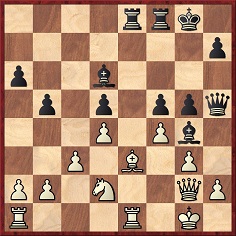
21...Re4 22 fxg5 f4 23 Nxe4 dxe4 24 gxf4 Bxf4 25 Bxf4 Rxf4 26 Qg3 Rf3 27 Qe5 Bf5 28 Rxe4 Bxe4 29 Qxe4 Rf7
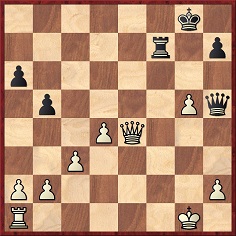
30 Qg2 Rf5 31 Kh1 Qf7 32 Kg1 Qe7 33 Kh1 Qf7 34 Rg1 Kg7 35 Qe4 Rf2 36 d5 Rxb2 37 c4 Rd2 38 Qe5+ Kg8 39 Qb8+ Kg7 40 Qe5+ Kg8 41 Qb8+ Kg7 Drawn.
(10947)
Olimpiu G. Urcan (Singapore) points out a ‘Myths & Legends’ article on pages 40-41 of CHESS, October 2018 in which Charles Higgie discusses Capablanca v Marshall, New York, 1918.
He lists three ‘myths’, and those 32 lines of text contain no facts not given in our feature article on the Marshall Gambit. There is even some verbatim copying, without a word of acknowledgement.
Concerning untrue claims that Marshall saved his Gambit for many years in order to surprise Capablanca, we wrote:
... between 1910 and 1918 the Cuban played 1 e4 against Marshall on six occasions. Five times the American responded with the Petroff Defence and once with the French Defence.
From Charles Higgie’s article:
‘Between 1910 and 1918 the Cuban played 1 e4 against Marshall on six occasions. Five times the American responded with the Petroff Defence and once with the French Defence.’
With regard to the game Frere v Marshall supposedly played in 1917, our article states:
Marshall published the Frere game on pages 110-111 of his rarely-seen book Comparative Chess (Philadelphia, 1932). ... A further curiosity in Comparative Chess is that on page 104 it was 7…O-O, rather than 8…d5, that Marshall emphasized. Of 7…O-O he wrote (incorrectly), ‘This move of mine, I claim to be original’.
Charles Higgie’s version:
‘Marshall published the Frere game on pages 110-111 of his rarely seen book Comparative Chess. A further curiosity in Comparative Chess is that on page 104 it was 7...O-O, rather than 8...d5, which Marshall drew attention to. Of 7...O-O, he wrote (incorrectly), “This move of mine, I claim to be original”.’
From page 3 of that issue of CHESS:

(11056)
On 13 October 2018 we sent CHESS a brief, purely factual, Letter to the Editor. The magazine decided to publish instead, on page 50 of the November 2018 issue, an apology which, though complimentary, was confused and confusing.
From page 8 A of the Philadelphia Inquirer, 6 March 1938, in Walter Penn Shipley’s ‘Chess and Checkers’ column:
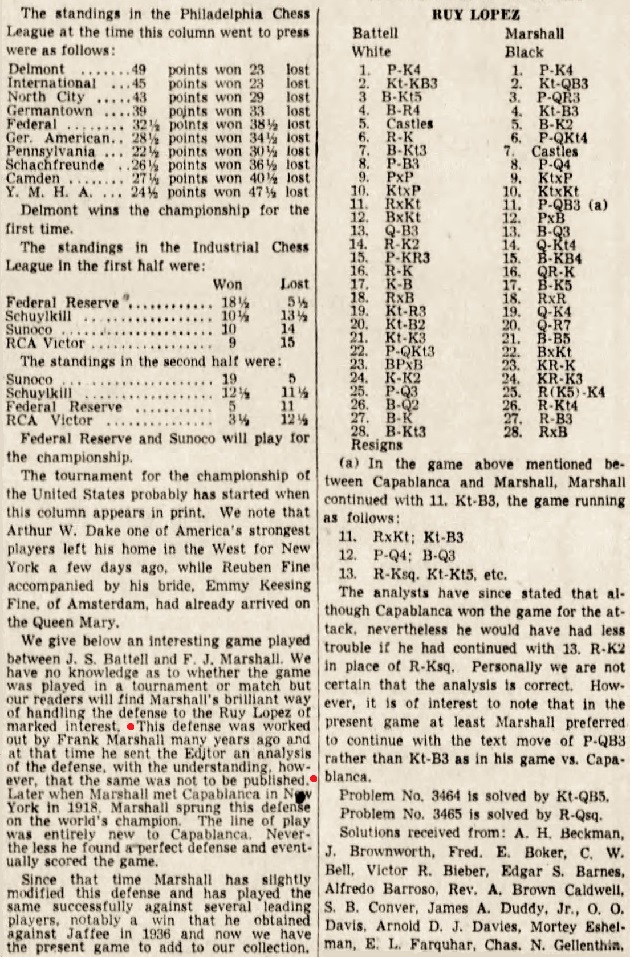
The Battell v Marshall game, played in the Marshall Chess Club Championship, is in databases (the bare score was published on page 7 of the January-February 1938 American Chess Bulletin), but the highlighted comment by Shipley about the Marshall Gambit pre-1918 is noteworthy.
Additional material from pages 151-152 of Kings, Commoners and Knaves:
On page 260 of the April 1974 Chess Life & Review Edward Lasker made the peculiar claim that it was only during the New York, 1924 tournament that Emanuel Lasker learned of the Marshall Gambit:
‘I had told him [Emanuel Lasker] on one of our morning walks in Central Park that during the war, when of course no chess news crossed the Atlantic, Marshall had invented a pawn sacrifice against the Ruy López which he had tried against Capablanca in a tournament in New York in 1918, but despite his tremendous attack, Capablanca succeeded in refuting it over the board. I told him how this “Marshall attack” went …’
The Capablanca v Marshall game had been published on pages 158-160 of the August 1919 Deutsche Schachzeitung and in the Cuban’s 1920 book My Chess Career.
On the subject of opening preparation, Marshall wrote in the final paragraph of the introduction to his 1914 book Marshall’s Chess “Swindles”:
‘The player who relies upon things he has “cooked up” beforehand to win his game is sure to lose in that power of self-reliant, ever-ready and active, over-the-board thought and command, which is at once both the great value and the chief source of success in the noble game of chess.’
‘A man who is known as the least bookish of all international players’ was Marshall’s description of himself in his introduction to Marshall’s Chess “Swindles” (New York, 1914).
(2149)
Frank Marshall’s famous game against Capablanca in which he unsuccessfully essayed the Marshall Gambit (though not after ‘saving it for ten years’ as some unreliable historians have asserted) was played in the first round of the New York tournament, on 23 October 1918. The event had been due to start the previous day, but according to a report in the Brooklyn Daily Eagle of 23 October, page 18 (reproduced on page 254 of the December 1918 American Chess Bulletin) Marshall was one of four participants who asked for a 24-hour postponement:
‘It appears that Marshall, who claims that, when he received an invitation to play, he had not had ample notice in order to get into training, was not in the mood to start. To top it off, he spent a very restless Monday night, and Mrs Marshall was on hand to prove it.’
(Kingpin, 2000)
Addition on 29 October 2023:
From page 152 of Re-Engineering the Chess Classics by Matthew Sadler and Steve Giddins (Alkmaar, 2023):
‘The same thing happened to Frank Marshall against Capablanca at New York 1918, when the latter sprung his eponymous gambit on the then World Champion.’
Addition on 29 January 2024:
Below is the chess report in the Brooklyn Daily Eagle of 24 October 1918, page 18:

‘N.T. Harrison’ was, if we may coin a neologism, the nom de non guerre of N.T. Whitaker.
See too Frank James Marshall.
To the Chess Notes main page.
To the Archives for other feature articles.
Copyright: Edward Winter. All rights reserved.